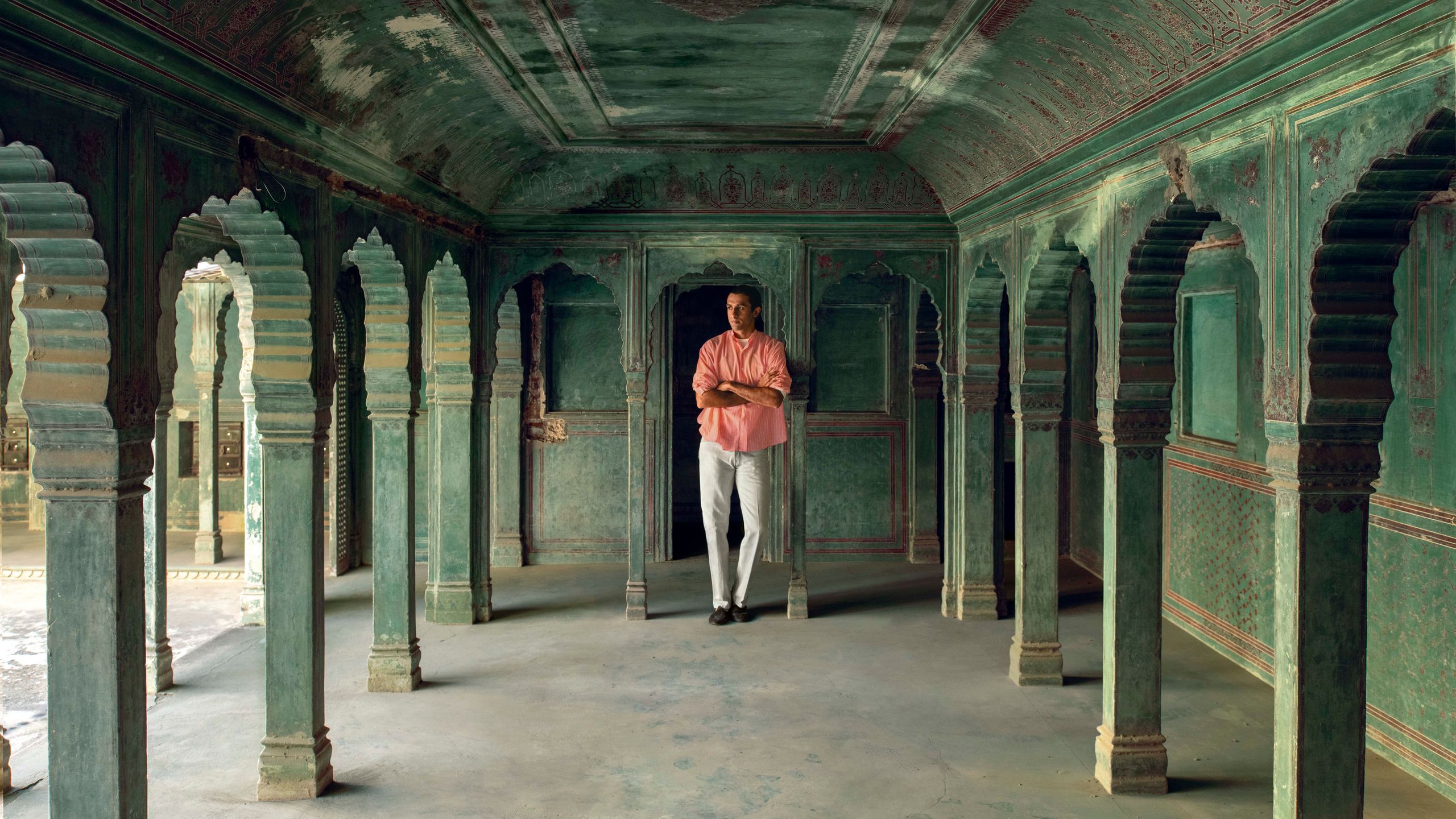In the 1920s, the painter Archibald Herman Müller was invited by Maharaja Sawai Man Singh II to Jaipur. The travelling artist, having started his career with the Rajput royal families by capturing the Bikaner family out shooting, was at the zenith of his career and set to work creating the cartouche portraits of the Kachhwaha rulers seen today in the mesmerisingly decorated Chandra Mahal veranda, its design inspired by Mughal carpets and part of the family quarters of the City Palace today. Such patronage was in keeping with the family’s longstanding and deeply visceral connection with the arts in the City of Jaipur. Today, that emotive lineage, which encompasses so many forms, from jewellery to folk music, has an eloquent and passionate champion in the person of Maharaja Sawai Padmanabh Singh, the 25-year-old head of the Jaipur royal family.
Sitting in a vine-curtained baradari overlooking the stretching lawns and clad in a simple white kurta, the elegant royal, celebrated for his sporting prowess, is quietly stepping into a deeper sense of vocation—and an ambitious project of revival for many of the until now veiled-away quarters of the rambling palace he calls his “favourite place in the entire world and where I find freedom of thought”. While we watch the fountains come to life across the lush Jai Niwas garden, “Pacho”, as he is known to family and friends, describes Rudyard Kipling being enamoured of them and the personal joy he has felt in overseeing their restoration; his enthusiasm is contagious and unexpectedly moving. “They are one of many unique elements here that I have been determined to bring back to life. Every nook and cranny of this place is a work of art, and I have been brought up to take none of it for granted.”
Padmanabh smiles before standing up to walk through a vividly blue corridor into a warren of courtyards, sleeping beauties each more beguiling than the last, sighing with patina and the flutter of the pachisi board. We find ourselves in an eerily lovely baoli—a stepwell—replete with delicate 18th-century columns and a marble slide, down which the royal ladies would amuse themselves in the hot season. As I remark on the pristine craftsmanship still evoking the spirit of the rajmistris who toiled to create such a jewel, Padmanabh reflects, “What people may not realize is that palaces like these were built to sustain a community, they gave work to hundreds of thousands of artisans and labourers. These chambers, once so alive, are evidence of our family’s loyal patronage and connection to the arts, many of which are dying.” Shifting to lean against a pillar as he relaxes while discussing a subject so obviously close to his heart, the budding renaissance maharaja continues; “Sawai Jai Singh [II] was so ahead of his time in making Jaipur the first planned city in India. He had a vision for it to be beautiful, dynamic and relevant, and, put simply, that very same approach is being carried like a torch by my family today. One of the conduits to that is our support of the artisans that descend from those brought in by my ancestors. I seek them out, encourage them and, when possible, I hope to support them in ever deeper capacities.”
When asked curiously as to when the enormity of his destiny came upon him, Maharaja Sawai Padmanabh Singh answers with candid openness that the moment of lighting his grandfather’s cremation pyre at the age of 12 “was a life-changing moment for me, following from driving through the city in a car with my sister, surrounded by throngs of mourners in white, many with shaved heads and weeping. It was a sort of ancient scene and I saw how entwined my family, and now I, was with the people.” One of the topics that makes him come alive is his position alongside the youth of Jaipur. He talks of the museums within the palace as being at the forefront of education, saying that, “Whatever your background, learning about your history is so important to one’s journey of self-discovery. Places like these really have the power to inspire people to learn about their roots.” Pausing and smiling with conviction he adds, “I hope we can make these palaces attractive to the youth of our country. These are places of participation, and, in a sense, belong to them.”
It is obvious that the planned resurgence of these gloriously painted and frescoed courtyards, mahals and pavilions are symbolic to Padmanabh of honouring the palace’s place, “built by the people and serving the people”. Walking through a saffron-yellow vaulted room dancing with European-style urn frescoes and a jade-green mahal filled with pink floral stencilling nearly as fresh as when they were painted, it is evident that, while the scale of work is imposing, these cloistered-away jewels of Jaipur’s architectural story are ripe for a new beginning, overseen by an evolving team of architects and craftsmen, over the coming years. “These spaces all have individual stories to tell,” reflects Padmanabh as he pushes open a door into a private puja area of the family, filled with an aura of sacred energy. “My focus will remain on ensuring that they retain their character in the process of restoration. We will be very careful in our selection of teams for these projects keeping in mind their historic age and relevance.”
As custodian of a palace that has evolved through the last three centuries in the most eclectic way, with every style that has passed through these parts, from Mughal diwans to Swinton Jacob’s colonial swagger and peach-hued art deco swimming pools, layered into a quixotic whole, the young royal has all the vim, vigour—and foresight beyond his years—to leave the stamp of a new generation, while honouring what has come before.
Turning to leave, he pauses thoughtfully and finishes. “I hope to become a bridge between the history of my lineage and the evolving contemporary world…to be remembered as a meaningful contributor to and a responsible custodian of the heritage of Jaipur.” As we say goodbye, his last words echo in my mind for days afterwards. “It would be wonderful if I could connect the modern youth of the world with the timeless stories here. That is my dream and one I hope to realise in the coming years.” There is no doubt that he will—a man and a mantle on the most humble of shoulders.

